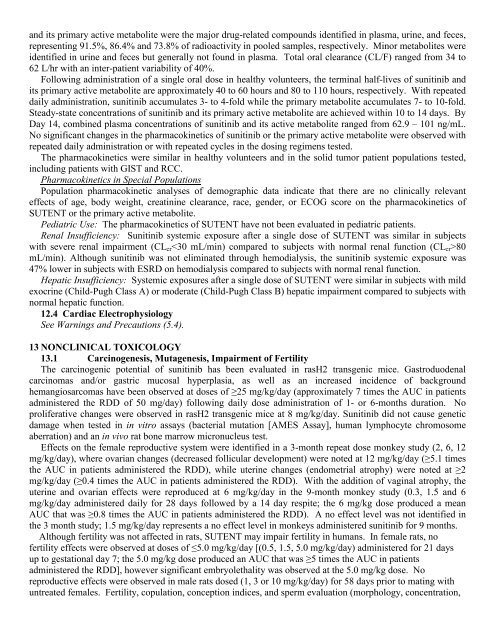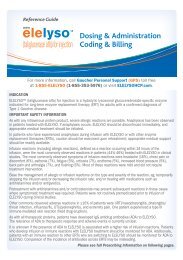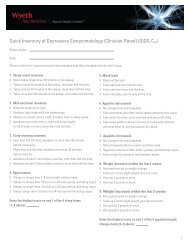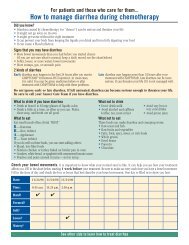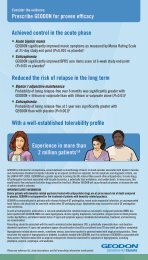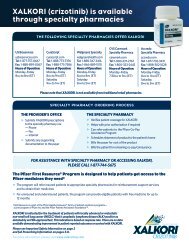You also want an ePaper? Increase the reach of your titles
YUMPU automatically turns print PDFs into web optimized ePapers that Google loves.
and its primary active metabolite were the major drug-related compounds identified in plasma, urine, and feces,<br />
representing 91.5%, 86.4% and 73.8% of radioactivity in pooled samples, respectively. Minor metabolites were<br />
identified in urine and feces but generally not found in plasma. Total oral clearance (CL/F) ranged from 34 to<br />
62 L/hr with an inter-patient variability of 40%.<br />
Following administration of a single oral dose in healthy volunteers, the terminal half-lives of sunitinib and<br />
its primary active metabolite are approximately 40 to 60 hours and 80 to 110 hours, respectively. With repeated<br />
daily administration, sunitinib accumulates 3- to 4-fold while the primary metabolite accumulates 7- to 10-fold.<br />
Steady-state concentrations of sunitinib and its primary active metabolite are achieved within 10 to 14 days. By<br />
Day 14, combined plasma concentrations of sunitinib and its active metabolite ranged from 62.9 – 101 ng/mL.<br />
No significant changes in the pharmacokinetics of sunitinib or the primary active metabolite were observed with<br />
repeated daily administration or with repeated cycles in the dosing regimens tested.<br />
The pharmacokinetics were similar in healthy volunteers and in the solid tumor patient populations tested,<br />
including patients with GIST and RCC.<br />
Pharmacokinetics in Special Populations<br />
Population pharmacokinetic analyses of demographic data indicate that there are no clinically relevant<br />
effects of age, body weight, creatinine clearance, race, gender, or ECOG score on the pharmacokinetics of<br />
SUTENT or the primary active metabolite.<br />
Pediatric Use: The pharmacokinetics of SUTENT have not been evaluated in pediatric patients.<br />
Renal Insufficiency: Sunitinib systemic exposure after a single dose of SUTENT was similar in subjects<br />
with severe renal impairment (CL cr 80<br />
mL/min). Although sunitinib was not eliminated through hemodialysis, the sunitinib systemic exposure was<br />
47% lower in subjects with ESRD on hemodialysis compared to subjects with normal renal function.<br />
Hepatic Insufficiency: Systemic exposures after a single dose of SUTENT were similar in subjects with mild<br />
exocrine (Child-Pugh Class A) or moderate (Child-Pugh Class B) hepatic impairment compared to subjects with<br />
normal hepatic function.<br />
12.4 Cardiac Electrophysiology<br />
See Warnings and Precautions (5.4).<br />
13 NONCLINICAL TOXICOLOGY<br />
13.1 Carcinogenesis, Mutagenesis, Impairment of Fertility<br />
The carcinogenic potential of sunitinib has been evaluated in rasH2 transgenic mice. Gastroduodenal<br />
carcinomas and/or gastric mucosal hyperplasia, as well as an increased incidence of background<br />
hemangiosarcomas have been observed at doses of ≥25 mg/kg/day (approximately 7 times the AUC in patients<br />
administered the RDD of 50 mg/day) following daily dose administration of 1- or 6-months duration. No<br />
proliferative changes were observed in rasH2 transgenic mice at 8 mg/kg/day. Sunitinib did not cause genetic<br />
damage when tested in in vitro assays (bacterial mutation [AMES Assay], human lymphocyte chromosome<br />
aberration) and an in vivo rat bone marrow micronucleus test.<br />
Effects on the female reproductive system were identified in a 3-month repeat dose monkey study (2, 6, 12<br />
mg/kg/day), where ovarian changes (decreased follicular development) were noted at 12 mg/kg/day (≥5.1 times<br />
the AUC in patients administered the RDD), while uterine changes (endometrial atrophy) were noted at ≥2<br />
mg/kg/day (≥0.4 times the AUC in patients administered the RDD). With the addition of vaginal atrophy, the<br />
uterine and ovarian effects were reproduced at 6 mg/kg/day in the 9-month monkey study (0.3, 1.5 and 6<br />
mg/kg/day administered daily for 28 days followed by a 14 day respite; the 6 mg/kg dose produced a mean<br />
AUC that was ≥0.8 times the AUC in patients administered the RDD). A no effect level was not identified in<br />
the 3 month study; 1.5 mg/kg/day represents a no effect level in monkeys administered sunitinib for 9 months.<br />
Although fertility was not affected in rats, SUTENT may impair fertility in humans. In female rats, no<br />
fertility effects were observed at doses of ≤5.0 mg/kg/day [(0.5, 1.5, 5.0 mg/kg/day) administered for 21 days<br />
up to gestational day 7; the 5.0 mg/kg dose produced an AUC that was ≥5 times the AUC in patients<br />
administered the RDD], however significant embryolethality was observed at the 5.0 mg/kg dose. No<br />
reproductive effects were observed in male rats dosed (1, 3 or 10 mg/kg/day) for 58 days prior to mating with<br />
untreated females. Fertility, copulation, conception indices, and sperm evaluation (morphology, concentration,


